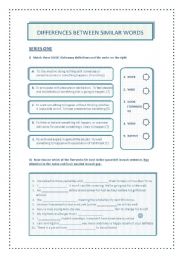
|
DIFFERENCES BETWEEN SIMILAR WORDS
This wss is intended to help intermediate ss distinguish between similar words that are easily misunderstood.
There are 5 series of 5 verbs each, which can be used as a whole or separately. Each series includes two tasks: matching and gap-filling in context.
The key for the teacher comes at the end of the wss
Level: intermediate
Age: 14-17
Type: worksheet
Downloads: 25
|
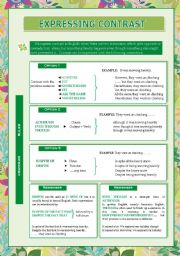
|
EXPRESSING CONTRAST
The worksheet explains, first, the concept of concession and how to express it. It also gives the grammar rules, the connectors, some examples, and particular features about expressing contrast. The second page presents a wide variety of exercises to practise with. Key.
Level: intermediate
Age: 14-17
Type: grammar-guide
Downloads: 420
|
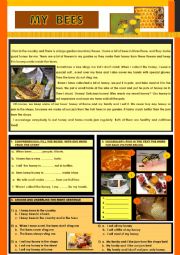
|
MY BEES
Elementary level. A simple reading about bees and producing honey.
Two comprehension exercises(finding the right word and multiple choice), and a picture-based vocabulary exercise. Key.
Level: elementary
Age: 10-12
Type:
Downloads: 38
|

|
BASIC ENGLISH GRAMMAR 1
A set of varied exercises intended for pre-intermediate students (comparatives/superlatives, ordinals, next/last, verb tenses, quantifiers some/any/much/many/a lot of, adverbs/adverbial phrases,articles,broken sentences). You can use them for an ordinary exam, a placement test or a class activity. As you wish!. Key.
Level: intermediate
Age: 12-14
Type: worksheet
Downloads: 170
|
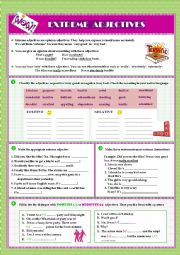
|
EXTREME ADJECTIVES
Explanation of the concept and what these extreme adjectives are used for. Some exercises to understand their positive or negative meaning (and compare to native language). Use of intensifiers. Practice of small dialogues. Pronunciation practice of the stressed syllable of these adjectives. Key provided.
Level: intermediate
Age: 14-15
Type: worksheet
Downloads: 208
|

|
CONDITIONALS TYPE III (upper-intermediate level)
My third wss on conditionals. This one deals with impossible conditional sentences (3rd type) and it�s meant for upper-intermedite sts. As in the others, you�ll find the explanation of the situations they are used in, the grammar rules and some other specific characteristics. It also includes quite a few exercises to practise. I have added the link...
Level: intermediate
Age: 14-17
Type: worksheet
Downloads: 580
|

|
RELATIVE CLAUSES
Intermediate to upper-intermediate level. Defining and non-defining relative clauses: definition and explanation through two charts, where you can understand when and how to use the various pronouns in their contexts. Omission of the relative pronoun. Difference between �what� and �that�. Some exercises on page 1 and plenty of them on page 2. Key
Level: intermediate
Age: 15-17
Type: grammar-guide
Downloads: 282
|

|
REPORTED SPEECH: DIALOGUES
This worksheet deals with reported speech for conversations. 3 parts: 1. A practical example to show how to change a short dialogue from direct to reported speech.
2. Some tips to remind sts. of key features when using reported conversations and finally 3 tasks (2 direct speech and 1 indirect speech) for sts. to apply all the rules and put them i...
Level: intermediate
Age: 14-17
Type: worksheet
Downloads: 269
|
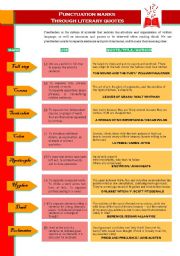
|
PUNCTUATION MARKS THROUGH LITERARY QUOTES
Upper-intermediate sts. are shown the rules to use the various punctuation marks through a literary quote that belongs to a title of an outstanding writer of the English/Irish/American literature.The practice with punctuation comes through 1) an extract taken from W. Faulkner�s masterpiece "The Sound and The Fury",2) some famous, well-known riddles...
Level: intermediate
Age: 14-17
Type: worksheet
Downloads: 202
|

|
SONG FOUNDATIONS BY KATE NASH
The story of a young couple who have split up their relationship (she�s just left home) because of the numerous problems that came up when living together: arguments, bad words, no respect for each other, too many beers.... Suitable for upper-intermediate sts. to work with vocabulary, informal expressions and with questions about the story in order...
Level: intermediate
Age: 14-17
Type: worksheet
Downloads: 28
|